THE BRILLIANT CUT DIAMOND
WHAT IS THE BRILLIANT CUT DIAMOND?
This post contains affiliate links. If you use these links to buy something I may earn a commission. Thanks! As an Amazon Associate I also earn from qualifying purchases.
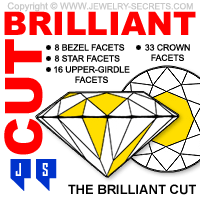
The most common shape of diamond in the world is the round diamond. Round is the default shape that everyone thinks about when they think of a diamond engagement ring.
The round diamond always comes to mind, but there are tons of other diamond shapes on the market as well. Shapes like: square, pear, heart, triangle, rectangle, oval…
Keep in mind, these are just shapes or outlines of the stone. The way that the diamond is cut is a whole different story (read more about diamond cut here).
Take a look at some Famous (Popular) Shapes of Diamond below…
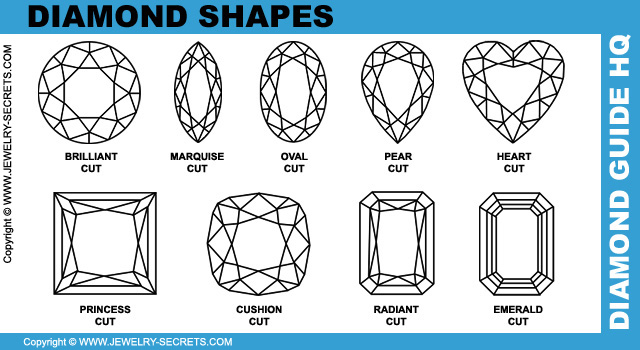
The cutting process is the actual sawing, bruting and blocking of the rough rock into a dazzling gemstone. Which leads us into…
The history of the brilliant cut
The cutting process began over 500 years ago and the modern diamond went through many changes over the centuries.
Starting out as nothing more than a pointy object, the diamond began to evolve, get more facets, until the diamond we see today was born.

The process goes from the point cut, which was just 2 points at either end of the stone, to the table cut, which shows the first signs of diamonds to come.
The table cut made diamonds easier to mount and wear in jewelry, rings, pendants, earrings and bracelets.
After that came the single cut diamond, which is still used today. The single cut has 17 or 18 facets on it and are usually found on diamonds 10 points (.10 CT) or smaller (also known as melee diamonds or accent stones).
A couple other cuts became popular over the ages as well: mazarin cuts, old-mine cuts and old european cut diamonds. You will still find these today in antique jewelry or vintage pieces.
These diamonds look different from today’s diamond because of the proportions and sparkle they give off. Back then, diamonds were cut by hand and not cut to maximize the light. They maintained carat weight (lumpy) and protection by cutting the culet off large to keep it from chipping.
This was all worth it because it gave way to the brilliant cut diamond.
The modern brilliant cut diamond
The diamond you see in jewelry stores today is the modern brilliant cut diamond. It has 58 facets on it (57 if there is no culet). See image below…
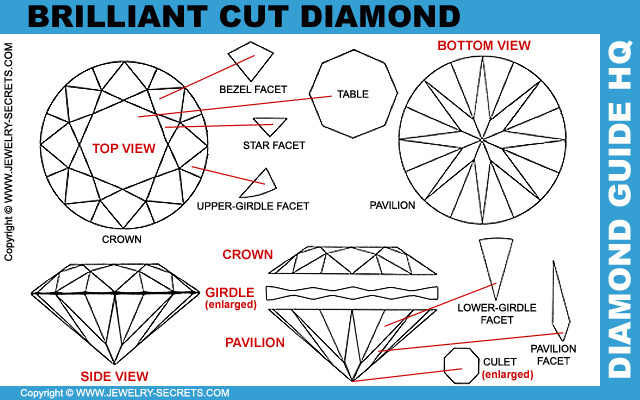
This style of cutting the facets into triangular shapes and kite shapes is what the brilliant cut does best. This cutting style is called brillianteering.
Modified brilliant cuts
Brillianteering is not only done with the round stone, but it’s done with other common cuts and shapes as well. Cuts like the princess cut, heart cut, pear cut, trilliant cut, radiant cut, oval cut, and marquise cut. See image below…
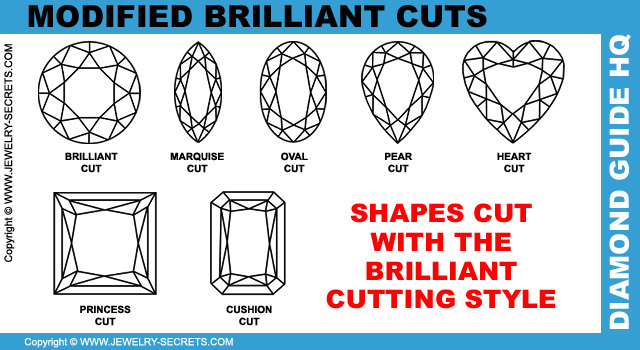
All of these diamonds are cut in the style of the brilliant style and called things like, modified brilliant cut or square modified brilliant on a GIA diamond report (certificate) as in the princess cut example below…
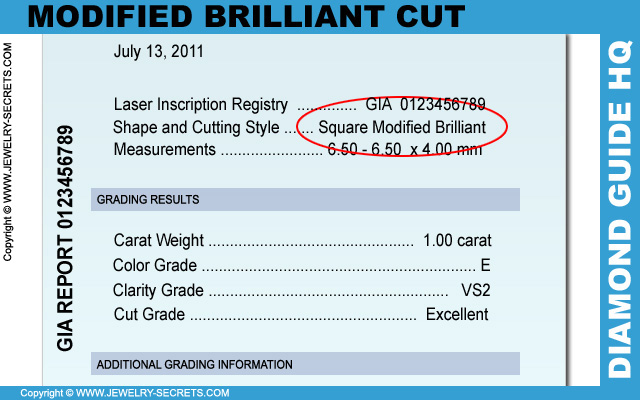
Brilliant cut facets
The brilliant cut diamond has 58 facets on the surface. 33 of these cuts are on the crown (top portion of the diamond), and 25 facets on the pavilion (bottom portion of the diamond). These two proportions are separated by the diamond girdle. One interesting thing to note about the girdle is this: The girdle can be faceted all the way around the stone, but these facets aren’t counted towards the overall facet number. They are just there for looks. :)
The facets on the crown of the diamond are:
|
|
The facets of the pavilion are:
|
|
Let’s take a closer look at these…
Crown Facets
The 33 crown facets of a diamond (those above the girdle) are:
Diamond Table
The diamond has one main facet called the table facet. This is the top flat part of the diamond, that is shaped like an octagon.
Diamond Star Facets
The crown of the diamond has eight star facets, which are triangular shaped facets. These facets go all the way around the diamond and give the table a cool star-like appearance.
Diamond Bezel Facets
There are eight bezel facets that go all the way around the outside of the diamond and are shaped like kites. These facets link the top table facet to the girdle.
Diamond Upper Girdle Facets
There are sixteen facets on the upper girdle. These outline the outer perimeter of the diamond. These 16 facets are also known as the upper halve facets.
Diamond Pavilion Facets
There are 25 facets that form the bottom (pavilion) of the diamond that are below the girdle:
Diamond Lower Girdle Facets
Sixteen lower girdle facets extend from the girdle down into the pavilion. These are long triangular shaped facets that help bounce light across the stone and come back out in a dazzling display of brilliance.
Diamond Pavilion Main Facets
Eight pavilion main facets connect the rest of the stone. These are long diamond or kite shaped facets that go from the very base of the diamond towards the girdle.
Diamond Culet
At the very end (point) of the diamond is where you will find the culet (if it has one). The culet is a small octagon shaped facet that keeps the diamond from breaking at the tip. You don’t need a culet, but it’s wise to have one. :)
Is this cut the most brilliant cut?
Yes it is, or should I say, it can be if the stone is cut well.
You see, just because the stone has these 58 facets on them doesn’t mean that these facets are proportioned properly, sized or placed correctly. The diamond could be short and fat, or it could be tall and skinny. It all depends on how the diamond is cut, which all depends on the parent rock and how much of the stone (making profit) they can utilize.
Take a look at the three diamonds below…
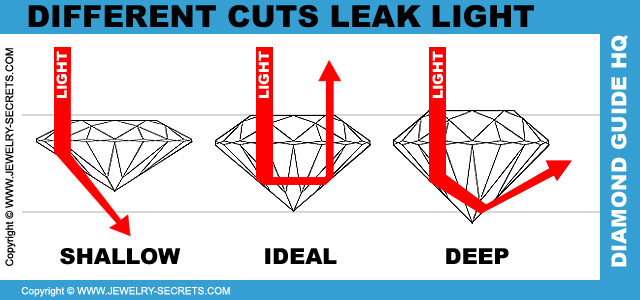
You can see one diamond is cut narrow and wide. Another diamond is cut deep and skinny. The last diamond is cut ideal to maximize light and sparkle.
The diamonds cut too deep or too narrow will leak light and lose sparkle.
Not only will there be a lack of brilliance, but if the stone gets too narrow, it can actually become very vulnerable to chipping or breaking at the girdle.
Because the loss of beauty, diamonds cut too narrow or too deep (will make the diamond cheaper) will often get weird reactions to light and sometimes even get a reflection of the girdle in the diamond (below the table).
A narrow stone can get a “fish-eye” circle around the table. While a deep stone can become dark in the center and resemble a “nail head“.
See image below…
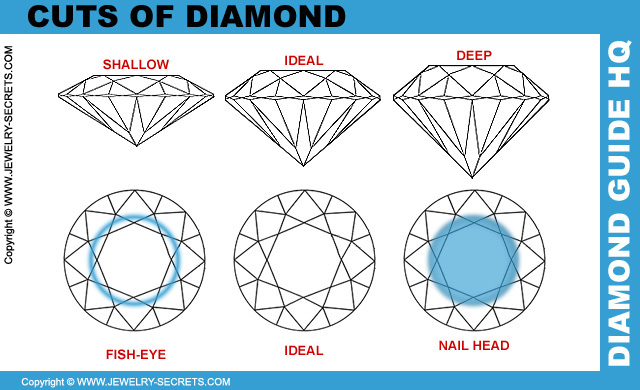
So you can see, a diamond cut more ideal, will give you the best results.
Ideal Cut Diamonds
Taking the brilliant cut diamond and making the most of it is what diamonds are all about. Without beauty and sparkle, a diamond is nothing. The only way to get this beauty, sparkle and brilliance is through the cut.
Marcel Tolkowsky perfected this cut in 1919. He measured the proper angles, crown height, diamond depth and percentages to arrive an an ideal cut standard.
The ideal cut is a small range that keeps the diamond in a sweet spot. This range allows for a maximum amount of both white light (brilliance) and colored light (fire) to balance the diamond and make the diamond come to life.
The proportions of an ideal cut diamond are below…
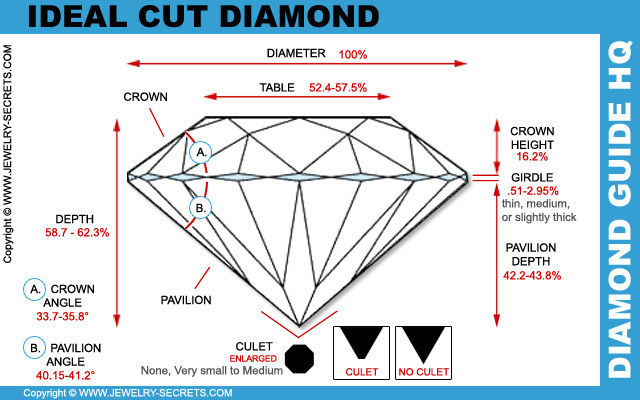
Most of the time you’ll concentrate on two main percentages: The table percentage and the depth percentage.
On a diamond certificate (like GIA), before 2005, these two percentages were really the driving force in teaching customers what to look for. Jewelers often refer to this as the 60/60 rule of thumb. 60% table, 60% depth. See image below…
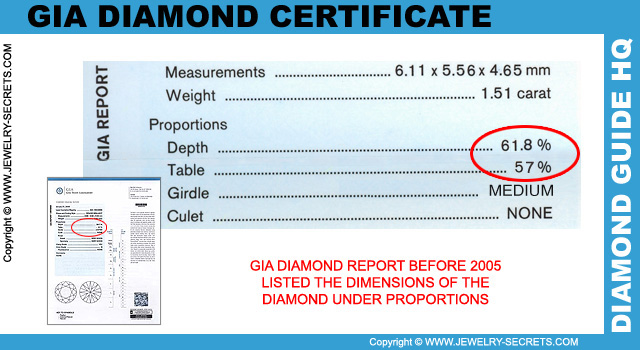
These percentages were close to ideal and if you got close to these set of numbers, you’d often get yourself a great looking diamond.
But that wasn’t always the case.
Just because a diamond had 60/60 didn’t mean it was good, nor gave off good brilliance and sparkle as in the examples below…
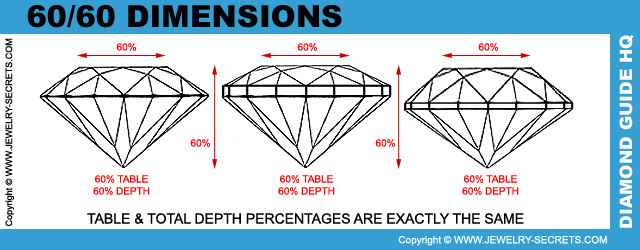
That’s why things had to change for the better. GIA set forth and created a new cut grade that took many things into consideration: Things like:
|
|
See picture below…
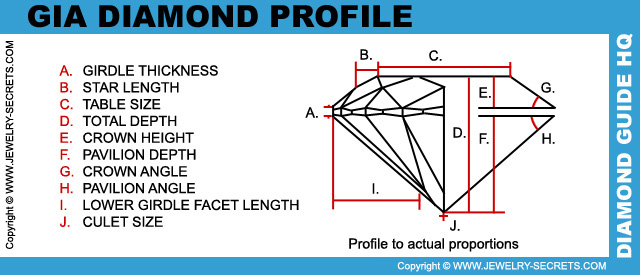
Now instead of looking at percentages and angles and trying to piece it all together, GIA made it simple for everyone. They rated the cuts from poor to excellent.
5 different cut grades now make the cut of a diamond effortless and easy to understand.
The 5 cut grades are:
Excellent, Very Good, Good, Fair and Poor. Let’s take a closer look…
Excellent Cut Grade
An excellent cut has excellent proportions and excellent light performance. The results of a top of the line cut like this is a very bright diamond. You can’t get better than this!
An excellent cut diamond needs to fall in a certain range of percentages and angles:
Brightness – High
Fire – High
Pattern – Minute Pattern Defects
Total Depth % – 57.5% – 63%
Table % – 52% – 62%
Crown Angle – 31.5° – 36.5°
Pavilion Angle – 40.6° – 41.8°
Crown Height – 12.5% – 17%
Star Facet Length – 45% – 65%
Lower Girdle Facet – 70% – 85%
Girdle Thickness – Thin – Slightly Thick
Culet Size – None to Small
Polish – Excellent to Very Good
Symmetry – Excellent to Very Good
Very Good Cut Grade
Very good cuts have great qualities and possibly some excellent qualities. Very good cuts contain great light performance and great proportions.
Some cuts of very good diamonds may have thick girdles or even shallow crown angles. Very good cuts are one of the best cuts you can buy.
The proportions of a very good cut diamond are:
Brightness – High to Moderate
Fire – High to Moderate
Pattern – Minor Pattern Defects
Total Depth % – 56% – 64.5%
Table % – 50% – 66%
Crown Angle – 26.5° – 38.5°
Pavilion Angle – 39.8° – 42.4°
Crown Height – 10.5% – 18%
Star Facet Length – 40% – 70%
Lower Girdle Facet – 65% – 90%
Girdle Thickness – Extremely Thin – Thick
Culet Size – None to Medium
Polish – Excellent to Good
Symmetry – Excellent to Good
Good Cut Grade
Good cut diamonds are average quality with good sparkle and good brilliance. Diamonds cut like this have some great qualities but lack other things like fire and brilliance that very good and excellent cut diamonds have.
Angles of the crown and pavilion could be deep or shallow and you may even see more dark areas in the center of the diamond. Overall this diamond is a good cut with good sparkle.
The proportions of a good cut are:
Brightness – Moderate
Fire – Moderate
Pattern – Noticeable Pattern Defects
Total Depth % – 53% – 66.5%
Table % – 47% – 69%
Crown Angle – 22° – 40°
Pavilion Angle – 38.8° – 43°
Crown Height – 9% – 19.5%
Star Facet Length – Any Value
Lower Girdle Facet – Any Value
Girdle Thickness – Extremely Thin – Very Thick
Culet Size – None to Large
Polish – Excellent to Fair
Symmetry – Excellent to Fair
Fair Cut Grades
Diamonds cut with a fair cut are not the brightest of diamonds.
You will probably see many dark shadows in the stone where the stone loses light and life. Cuts like this can be very steep, lumpy or very shallow and thin (cheaper cuts).
The proportions of a fair cut are:
Brightness – Moderate – Low
Fire – Moderate – Low
Pattern – Obvious Pattern Defects
Total Depth % – 51% – 70.9%
Table % – 44% – 72%
Crown Angle – 20° – 41.5°
Pavilion Angle – 37.4° – 44°
Crown Height – 7% – 21%
Star Facet Length – Any Value
Lower Girdle Facet – Any Value
Girdle Thickness – Extremely Thin – Extremely Thick
Culet Size – None to Very Large
Polish – Excellent to Fair
Symmetry – Excellent to Fair
Poor Cut Grades
Poor cut diamonds don’t sparkle much. The angles and proportions and symmetry may be all over the place.
The depth could be very deep or very lumpy. A cut like this could also be very thin and vulnerable to chipping or cracking.
The culet sizes could be thick and off center (as noticed by looking down into the table). The facets could be out of alignment. Tables may be skewed or slanted. The crown could be tilted.
Diamonds like this lack life and light.
The proportions of a poor cut are:
Brightness – Low
Fire – Low
Pattern – Prominent Pattern Defects
Total Depth % – <51% – >70.9%
Table % – <44% – >72%
Crown Angle – <20° – >41.5°
Pavilion Angle – <37.4° – >44°
Crown Height – <7% – >21%
Star Facet Length – Any Value
Lower Girdle Facet – Any Value
Girdle Thickness – Extremely Thin – Extremely Thick
Culet Size – None to Extremely Large
Polish – Excellent to Poor
Symmetry – Excellent to Poor
The bottom line
If you want to see if your diamond is cut well, check the cut grade on a diamond report (I prefer GIA).
You can look at the percentages and numbers in the diamond profile in the center of the report. See image below…
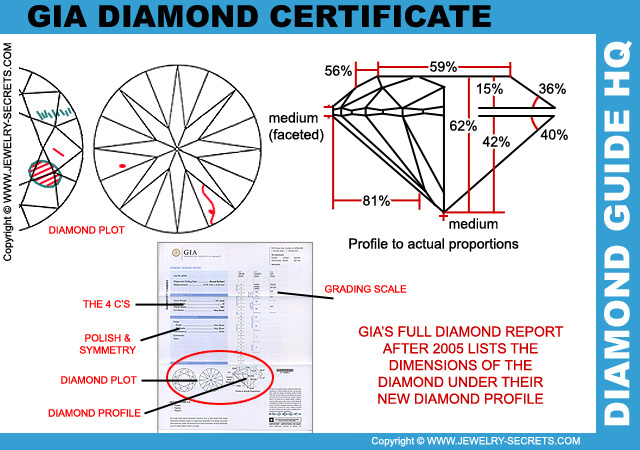
But this really isn’t necessary.
What is necessary is to stick to cuts that are graded Very Good or Excellent.
If you want to get an awesome diamond with awesome sparkle, buy a certified brilliant cut diamond and check the cut grade. :)
It can’t get any better than that… Except for a higher clarity or a higher color of course.
P.S. James Allen has a huge selection of high quality diamonds in stock. Plus you can use their virtual loupe to see what’s inside the stone. See below…
Enjoy! :)


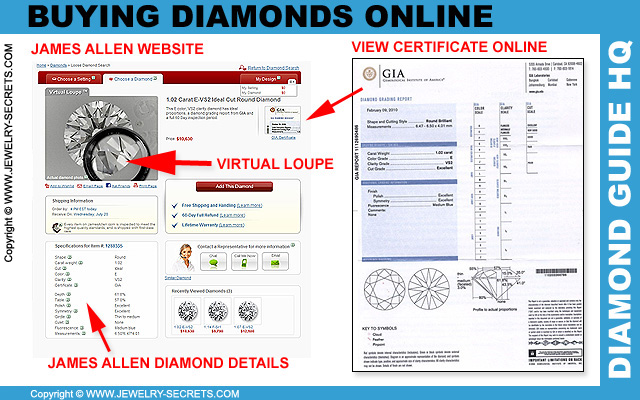
















Leave a comment